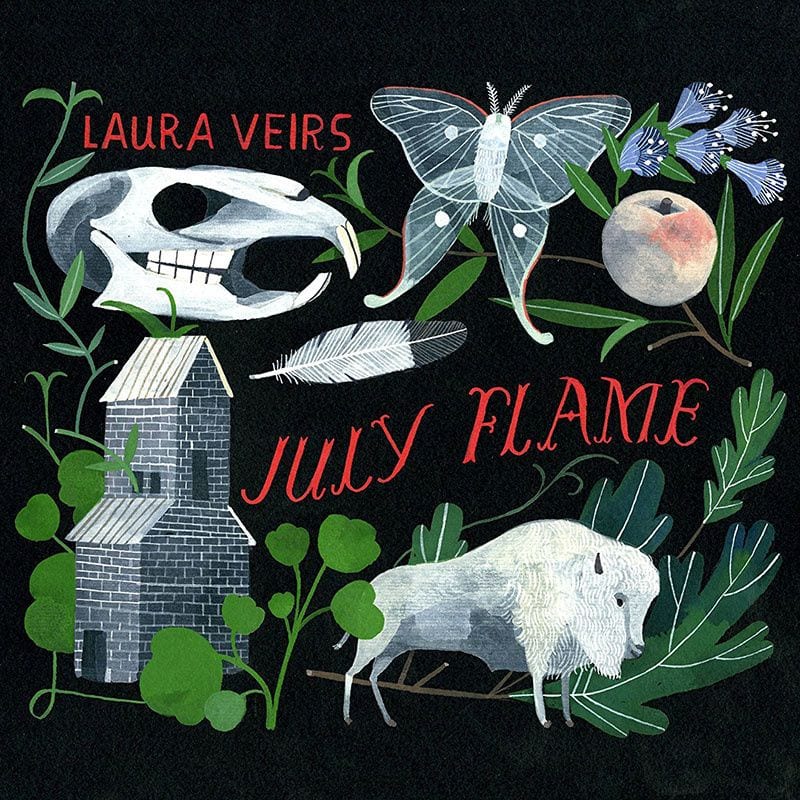
Compared to Laura Veirs’ last two “beyond” folk albums on Nonesuch, July Flame will appear to some ears as a back-to-basics or purer folk album. But that would be too nearsighted an inference.
If on her first album Veirs captured a beautifully simple folk coffeehouse ethos, marked by sweet warbles and interesting if generically perfunctory acoustic picking and strumming, this album is far too “produced” to retain much of an applicable folk moniker, and boyfriend-producer Tucker Martine deserves a lot of credit for keeping Veirs’ silky throat at the center of these more-than-folk compositions. While there is an acoustic kernel on almost all of these songs, a little acoustic guitar or piano riff of two bars repeated dutifully but hardly monotonously for two or three minutes, the electric elements are also capacious, from guitars to synthesizers, on some songs.
Really only about half of the album (six of 13 songs) is even purely acoustic, and even there, the sound is much closer to a Sufjan Stevens type of orchestral or chamber pop sound, replete with violins, pedal steel, piano, even saxophone and trumpet on a couple of numbers. This works whether it is the strings responding to Veirs’ “Can I call you mine” on the title track, or the banjo on “Where are You Driving?”. This is a very well-produced album full of an array of spicy accompaniment. The great production is not just evidenced in the instruments, but also the wonderful harmonies and choral echoes. The tracks are wonderfully patient, building and growing, gaining weight and then shedding it.
As for the vocals, the style and particular sound bear strong resemblance to lovely indie and more popular alternative predecessors, such as Sundays (especially), Suzanne Vega, Rose Melberg, and Liz Phair. All have a distinct timbre to them, sweet and/or airy, regardless of the lyrical focus. Furthermore, there’s a sense that the style of music on this album bears the historical signs of a shared culture of indie composers today (and recent years), for example the rockin’ piano a la Spoon and Wilco of yesteryear. The superb strategic use of strings, pedal steel guitars, and other instruments on many tracks also reminds one of various efforts by Sufjan Stevens and Andrew Bird when they choose to go orchestral. The otherworldly wailing that launches “Carol Kaye” recalls My Morning Jacket. One could go on and on. There is nothing derivative here. However, there is a historically exciting aura around all of it, and this album will be remembered as such.
Thematically, the album is sprinkled with metaphors of spring and summer, of warmth, and of love in bloom, most likely the autobiographical fruit of the relationship with producer-boyfriend Tucker Martine. She sings on “Where are You Driving?”:
And we danced away the hours…
Life is good when the band is smokin’ hot
And you know he feels the same thing….
Go inside, light the shoots of spring, unfurling on the lawn
You know he’d do the same thing
On the gorgeously airy “Little Deschutes” (a county and river in her native Oregon), Veirs is even more straightforward: “Peace I’ve known, floating log, deep green river… Something like peace of heart to make with you, my whole life long. I want nothing more than to dance with you, than to flow with you.” No lover could ask for a lovelier expression of commitment. The song transports the listener into a flotation chamber of aural pleasure.
The lyrical material ranges between celebratory love and existentially thought-provoking images developed into a meditation on the movingly memorable “Sleeper in the Valley”. In that song an acoustic guitar (and later violins) plucked in sharp staccato style combine with Veirs’ angst-tinged full notes to convey a poignant existential magnitude. She sings of “a young soldier under the cloud, his mouth is open, the light rains down / And the light rains down, and the crowns come round, to the two red holes in his right side”. The listener is immediately drawn into the scene, the sadness, the wonder. Who is she describing? “He’s just a kid, and he never knew, he would be sleeper in the valley so soon. So soon so soon and the crows they swoon at the two red holes in his right side…” She sings wonder-struck at the riddles of the universe, like a character in a canonical Stephen Crane short story who is obsessed with the vision of a soldier of the French Foreign Legion, a lone dying body on the beach of Algiers.
Veirs continues to mature as a songwriter and composer, and Martine knows how to bring out the best in her. All of these songs build from more simple riffs to fleeting layers and orchestral flourishes, with an impressive array of backup vocal and instruments. Sweet and sour in perfectly produced measure, July Flame will easily be one of the best albums of the year.

![Call for Papers: All Things Reconsidered [MUSIC] May-August 2024](https://www.popmatters.com/wp-content/uploads/2024/04/all-things-reconsidered-call-music-may-2024-720x380.jpg)



